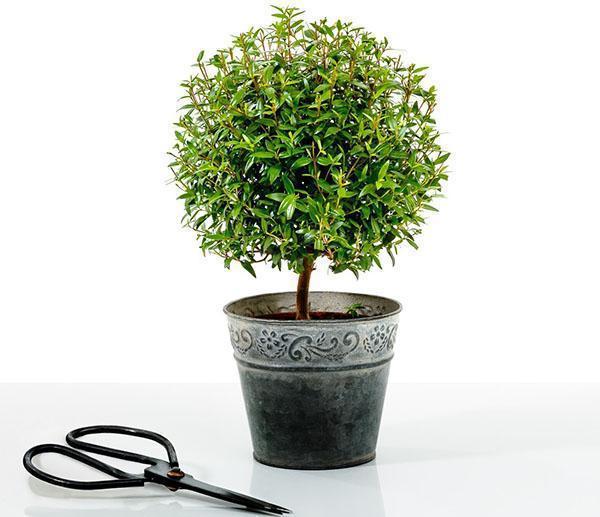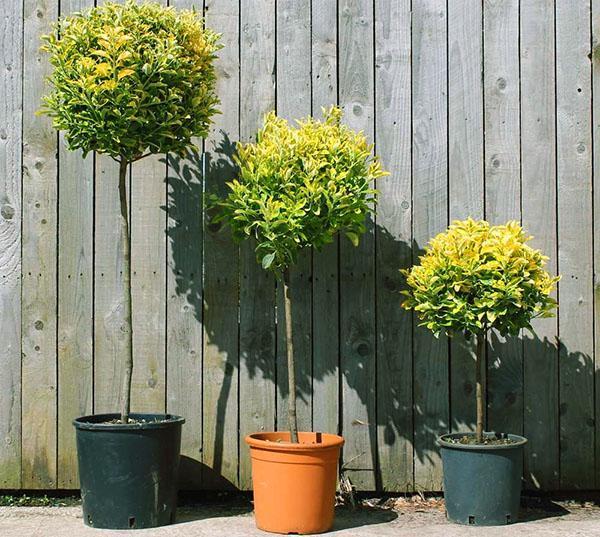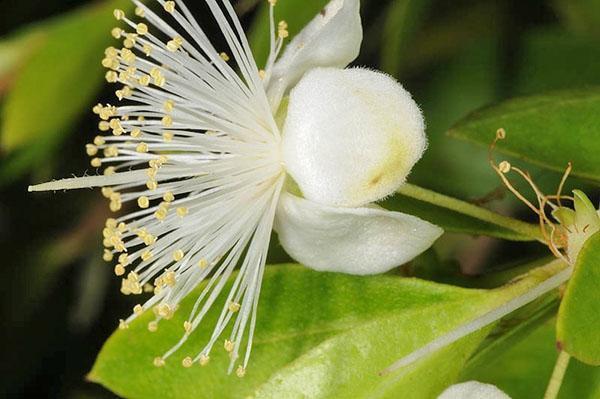Myrtle at home does not require complex care
 Myrtle, considered a symbol of peace, youth, love and marriage, has long been revered and grown in various countries. And today, flower growers are not averse to seeing myrtle in their collection, which can be mastered by a beginner at home.
Myrtle, considered a symbol of peace, youth, love and marriage, has long been revered and grown in various countries. And today, flower growers are not averse to seeing myrtle in their collection, which can be mastered by a beginner at home.
In a pot culture, two varieties of this evergreen can most often be found. These are common myrtle, or Myrtus communis, and small-leaved myrtle, Myrtus microphylla. In nature, the diversity of species is much wider. Today, botanists have about a hundred varieties of this culture, found in subtropical and tropical regions on both sides of the equator.
Evergreen myrtle in a pot culture

Caring for a myrtle tree at home will not be difficult, and the plant gratefully responds to care with flowering and even fruiting. Myrtle flowers resemble those of Chinese camellia. Thanks to the large, protruding stamens, they seem fluffy and perfectly decorate the house in the first half of summer.
 If, in the process of caring for myrtle, artificial pollination is carried out, by autumn the shrub will be covered with blue-black berries. The seeds inside ripe fruits sprout and can be successfully used for propagation of indoor crops.
If, in the process of caring for myrtle, artificial pollination is carried out, by autumn the shrub will be covered with blue-black berries. The seeds inside ripe fruits sprout and can be successfully used for propagation of indoor crops.
The culture is valued as a source of essential oil, the aroma of which is easy to feel by kneading a couple of small leathery leaves thickly covering the shoots in your fingers.
Growing evergreen myrtle will bring a lot of interesting observations and pleasant moments to the grower. But how to care for myrtle at home? What are the requirements for the content of this Mediterranean species?
How to care for myrtle?
In indoor conditions, the myrtle has shown itself to be a rather non-capricious plant, gratefully responding to care. With proper care of myrtle, regular formation of the crown and the correct selection of the place, the pot culture pleases with dense greenery, compact form and the absence of diseases.
The plant is photophilous, great for watering and spraying, but it is not advisable to place a pot of myrtle in hot stuffy rooms. In the cold season, a green pet needs a cool winter.
The best place for myrtle is where the plant will be under bright, but not scorching sun for a long time. If the pot is exposed to the south window, it is useful to shade the bush at midday. But on the northern side, the plant feels uncomfortable, the foliage loses its brightness, growth slows down, and you can hardly expect flowering in conditions of a lack of light.
 How to care for myrtle at different times of the year? From spring to mid-autumn, while there is no frost, the pot can be kept on the balcony, loggia or in the garden, only slightly sheltering it from the wind and sun. Here the plant is watered feed and protect from pests, because the risk of their attack outdoors increases significantly. In winter, caring for myrtle at home changes, which is caused by the natural cycle of plant development and the change of season.
How to care for myrtle at different times of the year? From spring to mid-autumn, while there is no frost, the pot can be kept on the balcony, loggia or in the garden, only slightly sheltering it from the wind and sun. Here the plant is watered feed and protect from pests, because the risk of their attack outdoors increases significantly. In winter, caring for myrtle at home changes, which is caused by the natural cycle of plant development and the change of season.
Seasonal changes in myrtle care
 How to care for a myrtle flower with the onset of autumn and winter? At this time, the plant slows down growth, rests from active vegetation and lays the foundations for future flowering. The optimum temperature for keeping myrtle in winter is 6–10 ° C. The coolness does not contribute to the rapid evaporation of moisture and its consumption by the myrtle itself, therefore, watering is reduced, making sure that the soil ball and roots do not dry out completely.
How to care for a myrtle flower with the onset of autumn and winter? At this time, the plant slows down growth, rests from active vegetation and lays the foundations for future flowering. The optimum temperature for keeping myrtle in winter is 6–10 ° C. The coolness does not contribute to the rapid evaporation of moisture and its consumption by the myrtle itself, therefore, watering is reduced, making sure that the soil ball and roots do not dry out completely.
Filling the soil in winter is extremely dangerous due to the risk of losing the entire bush, which inevitably rot roots in the cold, damp earth.
If the plant is left to winter at normal room temperature, it needs regular watering and mandatory irrigation of the crown. Such a measure will help myrtle cope with being in a dry room atmosphere. A sign of a lack of moisture and discomfort in this case is withering and falling leaves. If you do not take urgent measures and do not take care of the myrtle, the pet will remain without foliage until spring, and in summer it will refuse to bloom.
Top dressing, pruning and transplanting indoor myrtle
 Top dressing of a myrtle indoor bush is carried out in two weeks and is combined with ordinary watering. The plant should be supported with mineral supplements and organics in spring and summer. In winter, such a care measure is no longer needed.
Top dressing of a myrtle indoor bush is carried out in two weeks and is combined with ordinary watering. The plant should be supported with mineral supplements and organics in spring and summer. In winter, such a care measure is no longer needed.
To get a compact, even crown, as in the photo, pruning and pinching of shoots is included in caring for myrtle at home.
The evergreen plant has long earned the love of flower growers who are fond of growing bonsai. The small-leaved form of the plant is ideal for these purposes, allowing you to get the most bizarre outlines after several years of painstaking care.
Myrtle tolerates pruning easily. But it is best to spend it in the spring, when active growth has not yet begun. In the summer, a radical change in the shape of the bush is not carried out, but during this period pinching of young growth is very effective, forcing the stems to bush.
Early spring is not only the optimal time for pruning, but also for transplanting a house myrtle tree.
 The root system of this culture is not characterized by rapid growth, but once every 3-4 years, an adult plant is nevertheless transferred to a larger pot, and it is useful to replant young seedlings annually. Myrtle feels good in light, loose soil of moderate nutritional value. A universal mixture for ornamental crops, and a homemade substrate from turf, peat, sand and humus are suitable for him. With proper care, myrtle at home grows and pleases the owner over the years, becoming a living symbol of prosperity, love and peace.
The root system of this culture is not characterized by rapid growth, but once every 3-4 years, an adult plant is nevertheless transferred to a larger pot, and it is useful to replant young seedlings annually. Myrtle feels good in light, loose soil of moderate nutritional value. A universal mixture for ornamental crops, and a homemade substrate from turf, peat, sand and humus are suitable for him. With proper care, myrtle at home grows and pleases the owner over the years, becoming a living symbol of prosperity, love and peace.
How can I make myrtle fluffier with abundant leaves?
Now it is too late to start forming the crown, nevertheless, it is autumn on the street and myrtle enters a period of dormancy. But in the spring, you can cut the bush by shortening too long branches, and cut off the tops on the rest. It will be necessary to pinch the tops of young shoots throughout the summer. This will stimulate the formation of side shoots and the crown will become thick.
I bought myrtle: I felt sorry for him, it was flooded, even mold appeared, at home after transplanting he dropped all the leaves. Can you do something?
With this behavior, myrtle could react to previous mistakes in care (bay) or to transplant. Also, when a plant is kept in a heated room in winter, with a temperature high enough for it (and myrtle hibernates in a cool place), it definitely needs humid air. Try spraying the bush. May be spilled for additional prophylaxis with a fungicide.